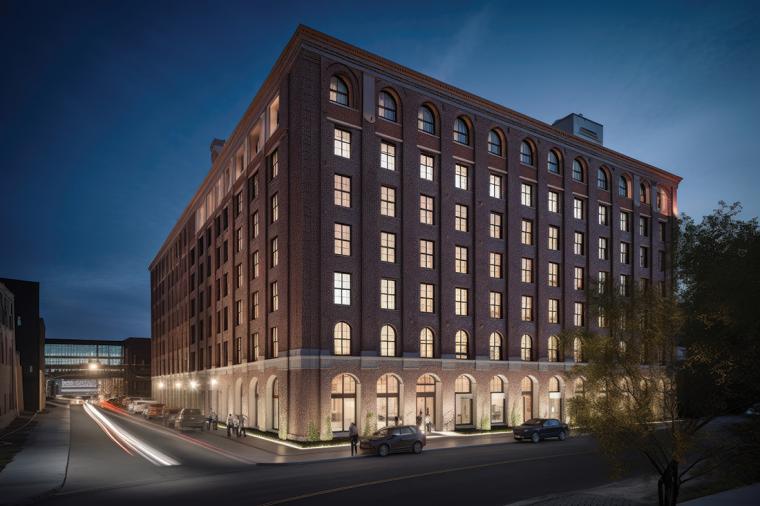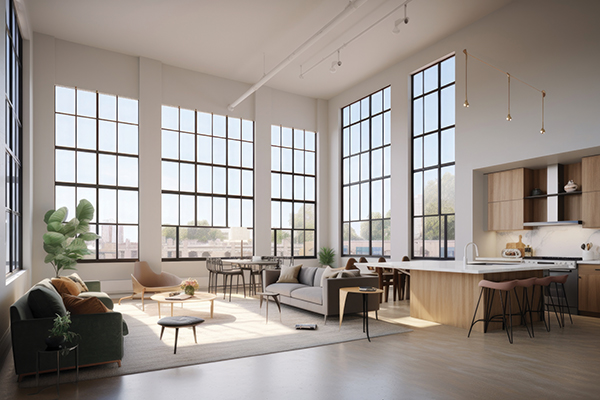
This decade has seen a transformation in the way we work, with technological advancements allowing for increased flexibility and remote work options. These factors, combined with economic downturns and changing business landscapes, have led to a rise in vacant office buildings across cities worldwide. These empty structures present both challenges and opportunities, sparking the need for innovative solutions to repurpose these spaces.With the shift to hybrid work models, there is much more unused office space available that, if converted to residential use, could help mitigate the shortage of affordable housing in the U.S. market. Depending on location, the economics of such a shift may not be supported by the differing pricing dynamics in these two asset classes; however, a variety of developing factors may make conversions more attractive and workable for investment.
More currently, the urban landscape has seen a significant shift in the use of vacant office buildings through a practice known as adaptive reuse. This innovative approach involves repurposing existing structures for new and often residential purposes, aiming to breathe life into abandoned spaces and address the pressing need for affordable housing. As the demand for urban living spaces continues to rise and traditional office spaces face increasing vacancies, adaptive reuse has appeared as a sustainable and economically workable solution to repurpose these buildings and revitalize communities.
Adaptive Reuse Defined
Adaptive reuse involves the conversion of existing buildings into new, functional spaces that differ from their original purpose. This approach allows for the preservation of architectural heritage while meeting the evolving needs of communities. In the context of vacant office buildings, adaptive reuse offers a promising alternative to demolition, reducing environmental impact and promoting sustainable development.
Economic Benefits
One of the key advantages of adaptive reuse is its economic viability. Transforming vacant office buildings into residential spaces or mixed-use developments can be more cost-effective than building new structures. The reuse of existing infrastructure reduces construction time, minimizes waste and often allows such projects to qualify for tax incentives, making this an attractive choice for developers and investors. The revitalization of these spaces also stimulates local economies by creating jobs, attracting businesses and increasing property values.
Preservation of Architectural Heritage
Office structures, especially those with historical significance, contribute to the architectural identity of cities. Adaptive reuse allows for the preservation of these structures, breathing new life into the old buildings, while keeping the character and charm of the surrounding neighborhood. This approach fosters a sense of continuity and cultural identity, creating a unique blend of historical and contemporary elements within urban landscapes.
Addressing the Affordable Housing Crisis
Adaptive reuse plays a crucial role in addressing the affordable housing crisis that plagues urban areas. By converting vacant office buildings into residential units, developers can quickly increase housing stock without the need for extensive new construction. This approach is particularly relevant in densely populated cities where available land is scarce and the demand for housing is high.
Community Engagement and Social Impact
The transformation of vacant office buildings through adaptive reuse goes beyond economic considerations. It also has a profound impact on community dynamics and social wellbeing. By repurposing these spaces for housing, developers contribute to the creation of diverse and inclusive neighborhoods. Adaptive reuse projects often involve community engagement, allowing residents to have a say in the transformation of their surroundings and fostering a sense of ownership and pride.
Sustainability and Environmental Benefits
In the face of climate change and increasing environmental awareness, adaptive reuse aligns with sustainable development goals. Repurposing existing structures reduces the need for new construction, saving energy and resources. Additionally, adaptive reuse minimizes the environmental impact associated with demolition, making it a more environmentally friendly alternative to traditional development practices.
Cities around the world have successfully implemented adaptive reuse strategies to address vacant office buildings and housing shortages. Examples include the conversion of former industrial warehouses in Brooklyn, New York into trendy loft apartments, and the transformation of disused factories in London into modern residential spaces. These case studies highlight the versatility and success of adaptive reuse in diverse urban contexts.
Making Adaptive Reuse Work
Research reported by RentCafe™ shows that 41 percent of converted apartments built in the last 24 months, or 13,250 units, have come from the conversion of former office buildings.
The growing trend of employees working remotely supplies clear indicators that office vacancy rates will, most likely, remain high as companies move to reduce their physical presence and the options available for utilizing the now vacant spaces become more limited.
While vacancy in existing office space continues to grow, adaptive reuse is also gaining momentum.
Cities are making progress implementing tax and development policies that will make these conversion projects workable.
Examples include:
• 25 Water Street, New York City. The biggest conversion project in the country to date will transform a former office building into 1,300 new apartments over the next two years. The building was purchased in December 2022 for $250 million and the developers closed on a $536 million loan to finance the redevelopment.
• One Wall Street, New York City. This conversion was completed in February 2023. The 1.25-million-square-foot building is now offering 566 housing units and 166 floor plans. The average sale price is $2,535,454 and rental price is $5,420.
• 4750 Wilshire Boulevard, Los Angeles. Construction started earlier this year to turn the former 144,300-square-foot building into a mixed-use opportunity. The plan is to convert the top two floors into 68 housing units while retaining 30,000 square feet on the ground floor for continued office use. Developers also plan to add amenities such as fitness centers and pools.
Other examples include:
Washington, D.C.
- Number of office-to-apartment conversions: 1,091
- Average rent in the city: $2,160 per month
- Notable office-turned-apartment building: The Wray, previously occupied by the State Department since the beginning of World War II.
Chicago, Illinois
- Number of office-to-apartment conversions: 1,020
- Average rent in the city: $2,059 per month
- Notable office-turned-apartment building: Millennium On La- Salle, a 13-story office building most recently known as Barrister Hall.
Alexandria, Virginia
- Number of office-to-apartment conversions: 955
- Average rent in the city: $1,902 per month
- Notable office-turned-apartment building: The Foundry, a mixed-use building with a food hall, coworking space and 520 apartment units.
Los Angeles, California
- Number of office-to-apartment conversions: 904
- Average rent in the city: $2,518 per month
- Notable office-turned-apartment building: The Mayer Building, an LA Art Deco landmark that will be converted into affordable housing.
Cleveland, Ohio
- Number of office-to-apartment conversions: 652
- Average rent in the city: $1,172 per month
- Notable office-turned-apartment building: Terminal Tower, a 52-story skyscraper that was the tallest building in the world outside of New York City when it was completed in the 1930s. Terminal Tower rises behind Public Park in downtown Cleveland, Ohio.
Philadelphia, Pennsylvania
- Number of office-to-apartment conversions: 591
- Average rent in the city: $1,736 per month
- Notable office-turned-apartment building: Lyndon at the Curtis, previously home to offices for the Saturday Evening Post and Ladies Home Journal.
Honolulu, Hawaii
- Number of office-to-apartment conversions: 571
- Average rent in the city: $1,943 per month
- Notable office-turned-apartment building: The Residences at Bishop Place, a 493-unit high-rise building in the city’s Financial District.
Nashville, Tennessee
- Number of office-to-apartment conversions: 458
- Average rent in the city: $1,581 per month
- Notable office-turned-apartment building: Lofts at the Reserve, formerly the Nashville branch of the Federal Reserve Bank of Atlanta.
Union, New Jersey
- Number of office-to-apartment conversions: 415
- Average rent in the city: $1,557 per month
- Notable office-turned-apartment building: The Titan Union, formerly the Union Center National Bank, now home to apartments, coworking space and an event hall.
Hyattsville, Maryland
- Number of office-to-apartment conversions: 338
- Average rent in the city: $1,580 per month
- Notable office-turned-apartment building: The Highline apartments, located in the 10-story Metro II building, first constructed in 1968.
Challenges and Considerations
While adaptive reuse presents benefits, there are challenges. Zoning regulations, building codes and structural limitations can pose obstacles to the transformation of office buildings into residential spaces. Balancing the preservation of architectural heritage with the need for modern amenities and safety standards requires careful planning and collaboration between developers, local authorities and communities.
When considering these types of conversions, one of the biggest challenges owners and developers face is whether and when their investments will pay off. It is expected that, by 2027, shifts in rents, valuations, acquisition costs and conversion costs, in addition to government-backed incentives, could allow developers to achieve a net profit on the conversions of vacant office space to housing.
Making the Bottom Line Work

Currently, real estate owners face financing issues due to elevated interest rates. But they aren’t doing it alone. Public/private collaborations with lenders focusing on community development and government agencies, as well as impact funds, may help with this transformation. Affordable housing stays at the top of the agenda for the federal government, with $213 billion planned in government incentives to support affordable housing under the $2.25 trillion infrastructure plan. Proposed legislation was modeled after the 2022 Revitalizing Downtowns Act, which aims to supply tax credits for such conversions.
Centralized land use planning, inclusionary zoning and state-level initiatives can make way for more market-rate developments with designated affordable housing that can help address the affordable housing gap. Distress in the office sector could lower valuations in the next two to three years. This may supply an opportunity for collaborations among developers, government bodies and lenders to prop up the affordable housing shortfall and revitalize downtowns. Stronger relationships between developers and local and state municipalities could be needed right now, especially in addressing the shortage of affordable housing in the United States.
In October 2023, the Biden administration released its initiative to restructure how federal agencies will approach adaptive reuse, primarily for housing. These actions are designed to address the pressing issue of affordable housing by advocating for the adaptive reuse of vacant office buildings. Recognizing the dual challenges of a shortage in affordable housing and a surplus of vacant office spaces, the administration has strategically aligned its goals with sustainable urban development.
By repurposing vacant office buildings into residential spaces, the administration approaches two critical issues simultaneously. Firstly, it addresses the growing demand for affordable housing, particularly in urban areas where the cost of living has risen substantially. Secondly, this initiative contributes to the broader goal of sustainable and resilient urban planning. Adaptive reuse minimizes the environmental impact associated with new construction projects by using existing structures and infrastructure. This aligns with the administration’s commitment to combating climate change and promoting environmentally conscious policies.
Concluding Thought
Overall, the push for adaptive reuse of vacant office buildings proves a forward-thinking approach to urban development, offering a practical and sustainable solution to the challenges of affordable housing and environmental responsibility in more densely populated urban areas. T&ID

